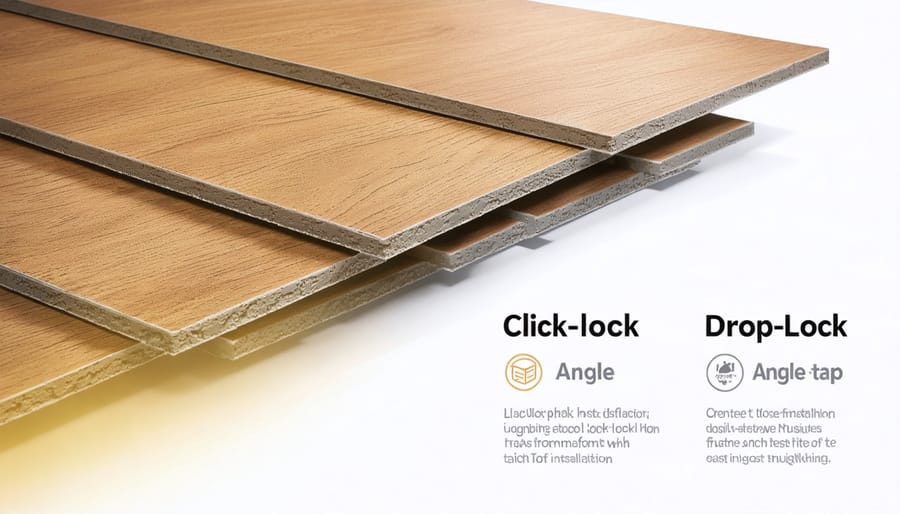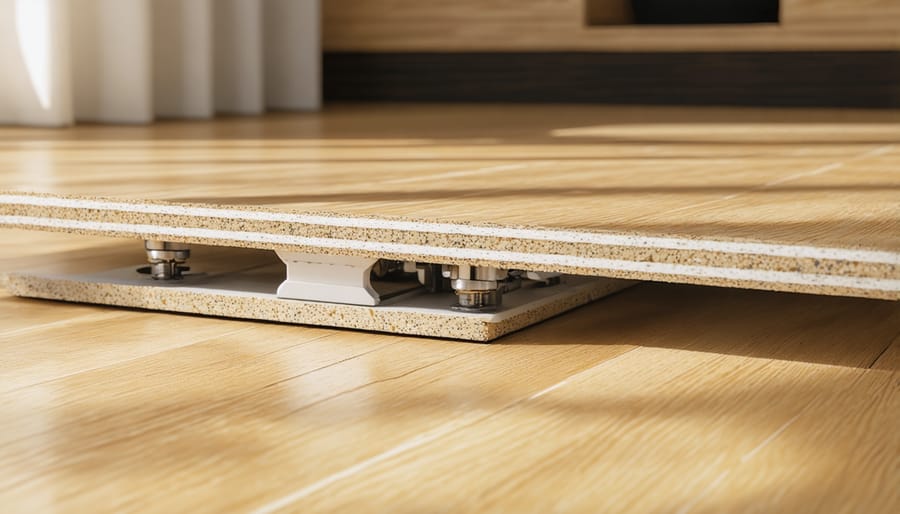
Which Laminate Floor Lock Makes Your DIY Installation Actually Work?
Choosing the right laminate flooring lock system transforms your installation from challenging to achievable. Among today’s modern flooring innovations, click-lock systems stand out for their user-friendly design and reliable performance. These ingenious mechanisms allow planks to snap together without glue, creating stable, gap-free floors that withstand daily wear. From the popular UniClic and 5G systems that click together horizontally to angle-tap designs that lock vertically, each mechanism offers distinct advantages for different room layouts and skill levels. Understanding these locking systems isn’t just about proper installation—it’s about ensuring your floor maintains its beauty and structural integrity for years to come. Whether you’re a first-time DIYer or an experienced installer, knowing the strengths of each system helps you make an informed choice that matches your project’s specific needs.
Click-Lock (Angle-Angle) Systems

Installation Process
Installing click-lock laminate flooring is surprisingly straightforward when you follow these simple steps. Start by laying the first plank in the corner of your room, ensuring you leave a 1/4-inch expansion gap along the wall. For the second plank, hold it at a 45-degree angle and slide the tongue into the groove of the first plank. Gently lower the plank until you hear a distinct clicking sound – this means they’re properly locked together.
Continue this process along the first row. When starting the second row, use the cut piece from the last plank of the first row to create a staggered pattern. For connecting rows, insert the long side first at an angle, then lift slightly and push down to lock the short ends together. You’ll feel and hear the mechanisms engaging.
Remember to tap the planks gently with a rubber mallet if needed, but never force them together. Work your way across the room, checking periodically that your rows remain straight. Most modern click-lock systems are designed to be foolproof – if you’re struggling to connect pieces, double-check your angle and alignment before proceeding.
Pros and Cons
Click-lock laminate flooring systems offer several compelling advantages for homeowners. They’re incredibly user-friendly, allowing for tool-free installation that even novice DIYers can handle with confidence. The secure locking mechanism creates tight, gap-free connections that help prevent moisture penetration and maintain floor stability over time. These systems also allow for easy repairs, as individual planks can be replaced without disturbing the entire floor.
However, there are some drawbacks to consider. Click-lock systems typically cost more than traditional tongue-and-groove options. The locking mechanisms can be somewhat delicate, and excessive force during installation might damage them, requiring plank replacement. Some systems may also be more challenging to install in tight spaces or around irregular shapes, as they require specific angles and movements to engage properly.
In rooms with significant temperature and humidity fluctuations, certain click-lock systems might develop slight gaps over time. While this is rare with quality products, it’s worth considering when choosing your flooring type, especially for spaces like basements or sunrooms.
Drop-Lock Systems
How Drop-Locks Work
Drop-lock systems are one of the most user-friendly installation methods for laminate flooring. These planks feature a specially designed end joint that literally “drops” into place when aligned correctly. To install, you’ll angle the long side of the plank into the previous row, then simply push the end down. When the plank drops, you’ll hear a distinctive clicking sound that confirms proper engagement.
What makes drop-locks particularly appealing is their simplicity – there’s no need for special tools or excessive force during installation. The mechanism works through gravity and clever engineering, with a plastic or metal insert that automatically locks when the plank falls into position. This system is especially helpful when installing under doorframes or in tight spaces where angling boards might be difficult.
While drop-locks are generally very secure, it’s important to ensure each plank is fully seated before moving on. A gentle tap with a rubber mallet can help guarantee proper connection.

Best Applications
Drop-lock systems are particularly well-suited for larger installation projects and commercial spaces where quick installation is essential. These systems excel in open-concept areas and rooms with long, uninterrupted runs of flooring, as they allow for rapid installation along lengthy wall-to-wall spans. They’re also ideal for DIY homeowners who want to tackle their flooring project without specialized tools or extensive experience.
The system works exceptionally well in rental properties and model homes where flooring may need occasional replacement, as individual planks can be easily removed without disturbing the surrounding floor. Basements and areas with slight subfloor irregularities benefit from drop-lock systems too, as the vertical locking mechanism helps maintain tight seams even with minor surface variations.
For rooms with unusual angles or multiple doorways, drop-lock systems provide the flexibility needed to work around these challenges while maintaining structural integrity. They’re also perfect for quick renovation projects where minimizing downtime is crucial.
Angle-Tap Systems
Installation Tips
When installing angle-tap laminate flooring, start at the left corner of your room and work from left to right. Place your first plank with the tongue side facing the wall, using spacers to maintain the recommended expansion gap. For the next plank, hold it at a 30-45 degree angle and slide the tongue into the groove of the first plank. Lower the plank while maintaining gentle pressure to ensure a secure lock.
For subsequent rows, begin with the leftover piece from the previous row if it’s at least 12 inches long. Position the long side of the new plank at an angle against the installed row, then slide it until it meets the end of the previous plank. Carefully lower while ensuring both the side and end joints connect properly.
If you encounter resistance, double-check your angle and alignment. Never force the planks together, as this can damage the locking mechanism. Keep your work area clean and free of debris for optimal installation results.
When to Choose Angle-Tap
Angle-tap systems are particularly well-suited for DIY installations in large, open spaces where you have plenty of room to maneuver planks. They excel in areas with consistent subfloor conditions and work best when installing flooring in newly constructed or renovated spaces. This system is ideal if you’re working on a project where you can easily lift and angle boards during installation, and you want a secure, long-lasting connection between planks.
Choose angle-tap when durability is your top priority, as these joints typically create the strongest connections. They’re excellent for high-traffic areas like living rooms and hallways, where flooring takes regular abuse. This system also performs exceptionally well in spaces with temperature fluctuations, as the locking mechanism allows for natural expansion and contraction while maintaining a tight seal.
For commercial installations or homes with active families, angle-tap’s superior stability makes it worth the slightly more involved installation process.

Making Your Choice
Choosing the right laminate flooring locking system doesn’t have to be complicated. Start by considering the room where you’ll install the flooring. For high-moisture areas like bathrooms or basements, opt for click-lock or angle-tap systems with enhanced moisture resistance. These systems, while potentially costlier, offer better protection against water damage and are worth the investment as part of your smart home improvements.
For DIY enthusiasts, fold-down systems are particularly user-friendly, requiring minimal tools and experience. If you’re new to flooring installation, these systems can save you time and frustration. However, if you’re confident in your DIY skills and working with a tighter budget, traditional tongue-and-groove systems offer excellent value.
Consider your subfloor condition as well. Uneven surfaces might benefit from systems with more forgiving installation tolerances, like angle-tap or click-lock mechanisms. These systems typically provide better stability over slight imperfections.
Budget plays a crucial role, but remember that the cheapest option isn’t always the most cost-effective. Higher-quality locking systems often last longer and perform better over time. Factor in installation costs if you’re hiring professionals – some systems require specialized expertise, which can affect overall project expenses.
Finally, think about future maintenance and repairs. Systems that allow for individual plank replacement, such as click-lock or fold-down mechanisms, can save money and hassle down the line. While these might cost more initially, the long-term benefits often justify the investment.
Choosing the right laminate flooring locking system is crucial to achieving a beautiful and durable floor that can truly transform your space. Each system offers unique advantages, from the user-friendly design of click-lock systems to the robust stability of fold-down mechanisms. For DIY installations, click-lock and angle-tap systems tend to be the most forgiving, while fold-down systems provide superior stability for high-traffic areas. Consider your skill level, room conditions, and intended use when making your selection.
Remember that proper installation technique matters as much as the locking system itself. Take time to acclimate your flooring, prepare the subfloor correctly, and follow manufacturer guidelines carefully. While some systems may cost more initially, the long-term benefits of easier installation and better durability often justify the investment. Whether you’re a first-time installer or an experienced DIYer, today’s innovative locking mechanisms make it possible to achieve professional-looking results in your flooring project.
